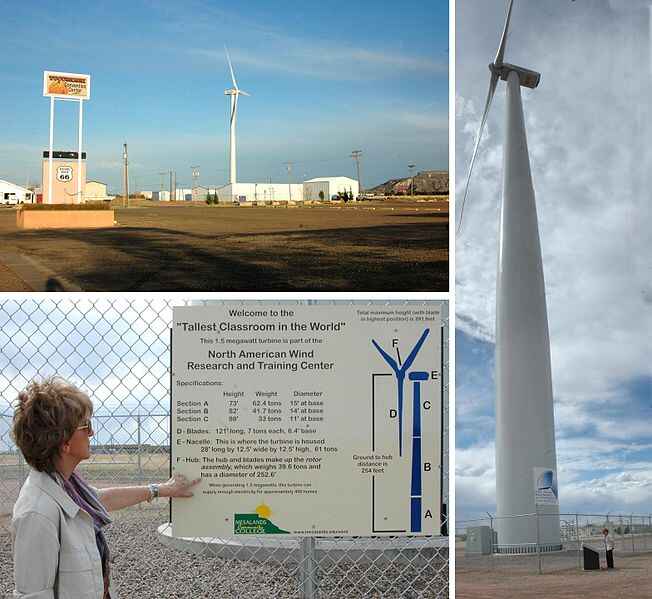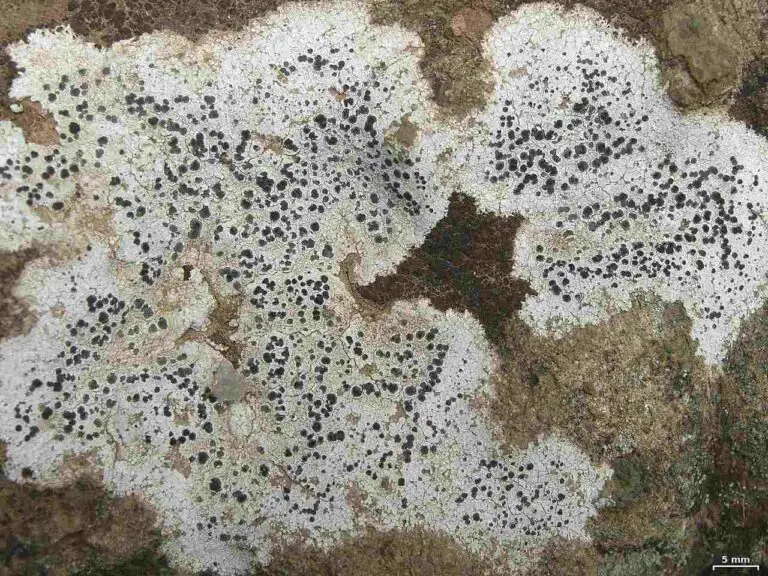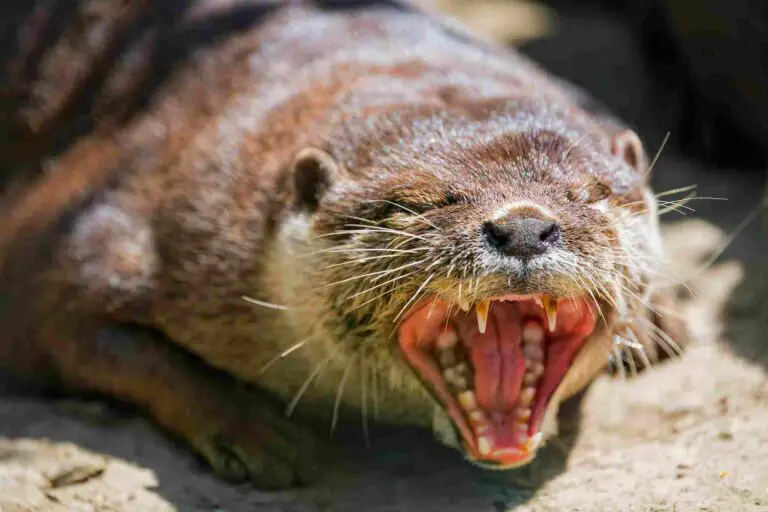Muskrat Vs Woodchuck Size, Weight, Overall Comparison
Comparing muskrats and woodchucks unravels the nuances between these brown-furred, stocky rodents. Despite some visual similarities, key distinctions in size, color, and tail characteristics set muskrats and woodchucks apart, enabling enthusiasts and observers to appreciate their unique traits.
I. Physical Characteristics:
– Both muskrats and woodchucks share brown fur and sturdy builds.
– Muskrats, however, are notably smaller and exhibit a color range from white to black.
– Woodchucks, in contrast, present thicker, shorter, and furry tails, setting them apart from muskrats.
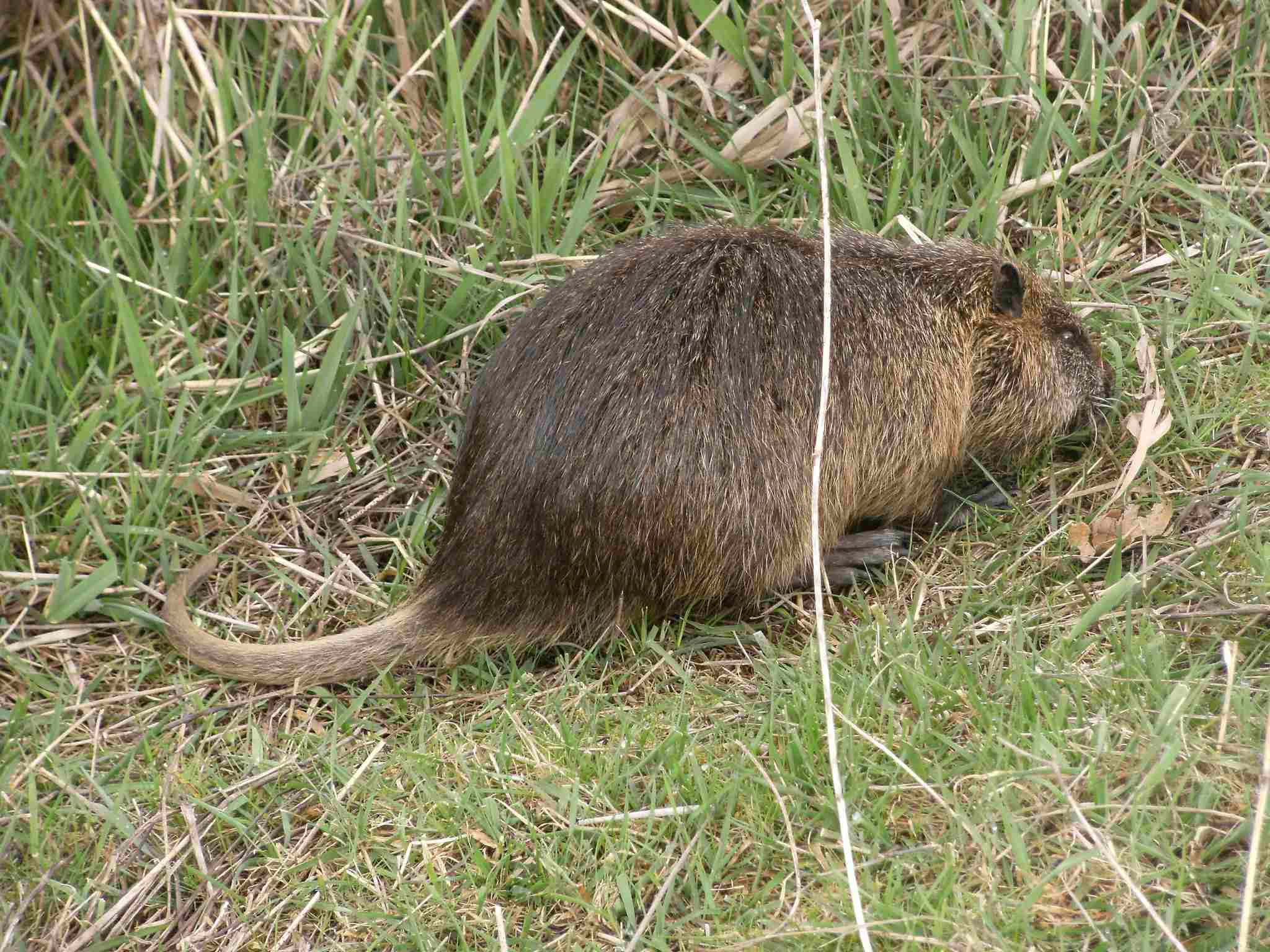
II. Size and Weight:
– Groundhogs, commonly known as woodchucks, are significantly larger than muskrats. Groundhogs can reach sizes larger than an average house cat, whereas muskrats appear more diminutive in comparison.
III. Tails:
– Muskrats boast hairless, scaly tails, which serve as a distinctive feature.
– Woodchucks, conversely, sport tails that are thick, short, and covered in fur.
IV. Habitat and Behavior:
– Muskrats are adept swimmers and are often found in aquatic environments, utilizing their long, scaly tails for efficient navigation.
– Woodchucks, also skilled diggers, are more terrestrial, creating burrows rather than engaging in aquatic activities.
V. Weight and Appearance:
– Muskrats typically weigh around 2 ½ pounds, showcasing a smaller and more streamlined physique.
– Woodchucks, with stout 10-inch bodies, present a bulkier appearance, emphasizing their larger size compared to muskrats.
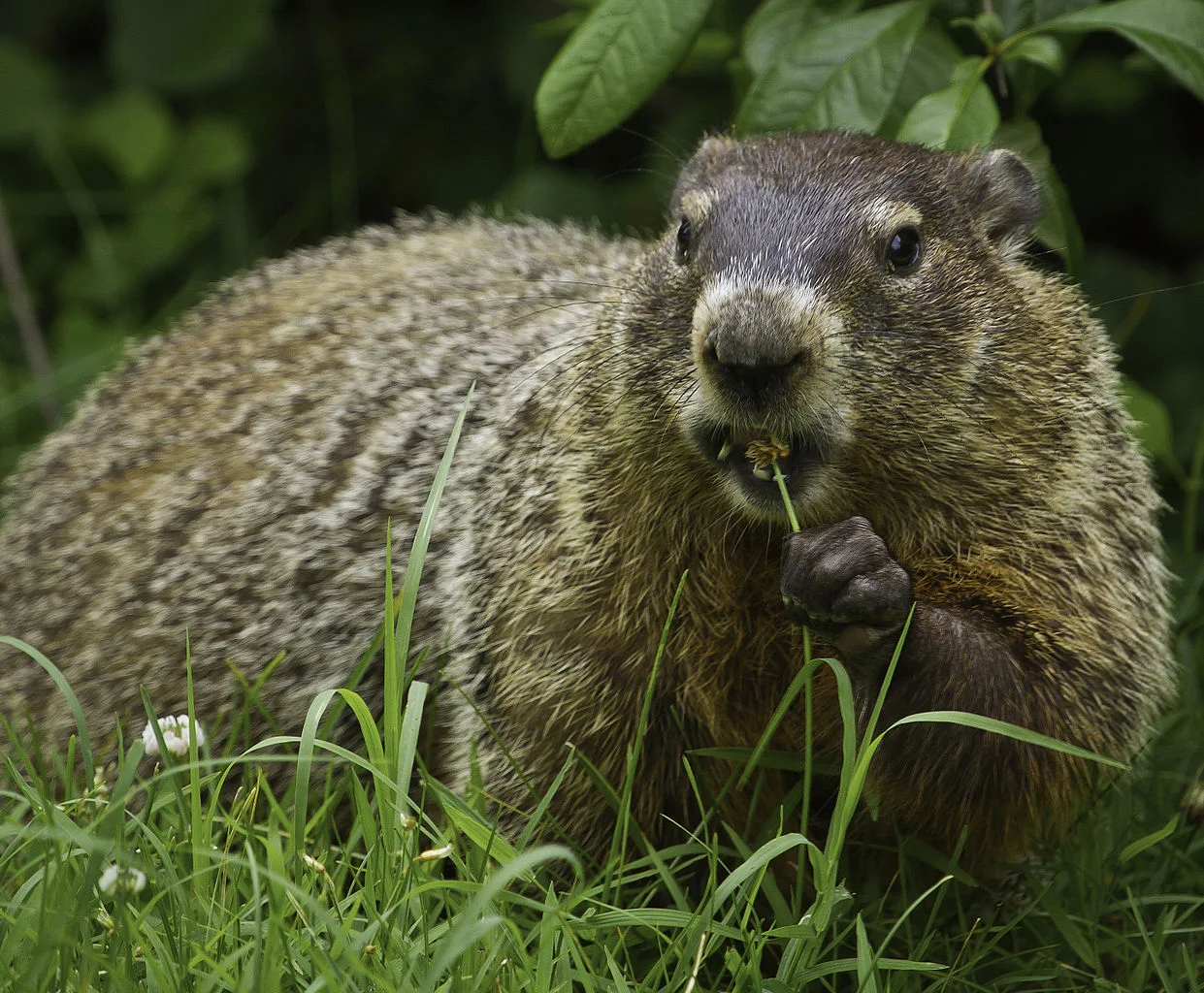
VI. Scientific Identification:
– Groundhogs and woodchucks share the same Latin name, Marmota monax, clarifying their taxonomic relationship.
VII. Cultural References:
– Discussions on platforms like Reddit and other online forums often involve questions regarding the distinction between muskrats and woodchucks, with community members providing insights into their characteristics.
VIII. Naturalist Observations:
– Naturalists and wildlife experts emphasize tail length, fur texture, and habitat preferences to differentiate between muskrats and woodchucks.
*Details of Comparison
| Criteria | Muskrat | Woodchuck |
| Taxonomy | Order Rodentia, Family Cricetidae, Genus Ondatra, Species O. zibethicus |
Order Rodentia, Family Sciuridae, Genus Marmota, Species M. monax
|
| Appearance | Streamlined, semi-aquatic, brown fur, flattened tail |
Terrestrial, robust build, brown to grayish-brown fur
|
| Size | 16-24 inches in length |
16-26 inches in length
|
| Weight | 1.5-4.5 pounds | 4-14 pounds |
| Dentition and Bite Force (PSI) | Sharp incisors for cutting vegetation |
Large incisors, strong bite force
|
| Physical Offensive Advantages | Agility and sharp incisors |
Strong forelimbs, sharp incisors
|
| Physical Defensive Advantages | Aquatic evasion |
Retreat to burrows, strong limbs
|
| Speed | Agile swimmers, ~3.5 mph |
Terrestrial runners, up to 8 mph
|
| Agility | Agile in water |
Agile on land, climbs, and digs
|
| Senses | Touch, hearing, good night vision |
Smell, good hearing, decent vision
|
| Overall Physical Capacity | Adapted for aquatic life |
Strong limbs for terrestrial life
|
| Habitat Preference | Wetlands, ponds; widespread in North America |
Open areas near woodlands; common in North America
|
| Tracks | Small, webbed footprints near water |
Distinctive prints with five toes, near burrows
|
| Lifespan | 2-4 years | 6-8 years |
| Mode of Feeding | Herbivorous, aquatic vegetation |
Herbivorous, various plants
|
| Intelligence | Limited cognitive abilities |
Considered intelligent, problem-solving
|
| Social Behavior | Generally solitary |
Primarily solitary, tolerant of conspecifics
|
| Mode of Reproduction | Seasonal breeding, multiple litters |
Seasonal breeding, one litter per year
|
| Parental Behavior | Limited parental care |
Maternal care, nursing, and protection
|
| Proximity to Human Areas | Wetland areas near humans |
Suburban and rural areas
|
| Behavior Toward Humans | Avoids direct contact |
Retreats to burrows, may tolerate human presence
|
| Danger Posed to Humans | Generally not considered dangerous |
Generally not considered dangerous
|
| Associated Precautions | Preserve wetland habitats |
Be cautious around burrows
|
| Conservation Status | Least Concern (LC) |
Not globally assessed, stable populations
|
Key Points
- Both are herbivorous rodents.
- Muskrats adapted to aquatic life; woodchucks adapted to terrestrial burrowing.
- Woodchucks have a longer lifespan and more extensive parental care.
- Woodchucks are more adaptable to human-inhabited areas.
- Conservation status is generally stable for both species.
1. Taxonomy:
Muskrat:
Kingdom: Animalia
Phylum: Chordata
Class: Mammalia
Order: Rodentia
Family: Cricetidae
Genus: Ondatra
Species: O. zibethicus
Woodchuck (Groundhog):
Kingdom: Animalia
Phylum: Chordata
Class: Mammalia
Order: Rodentia
Family: Sciuridae
Genus: Marmota
Species: M. monax
2. Appearance:
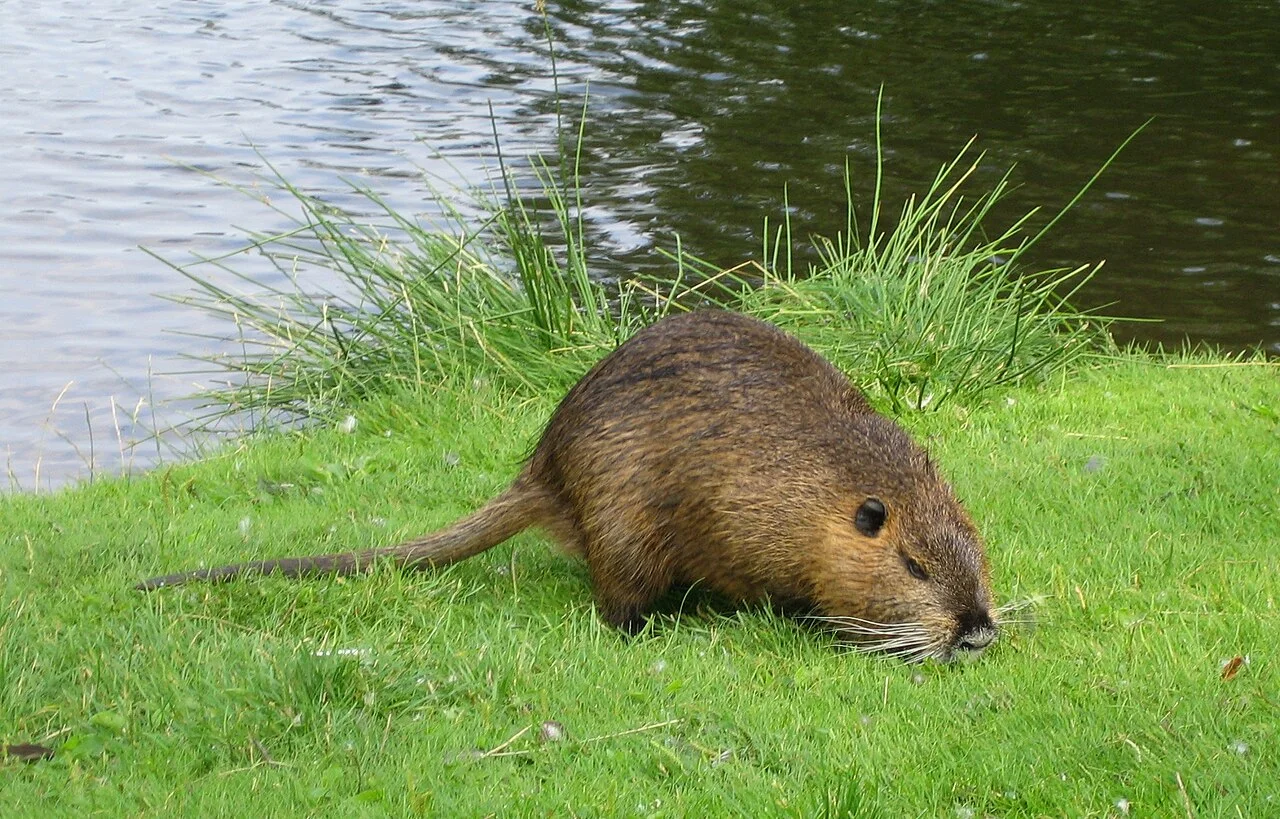
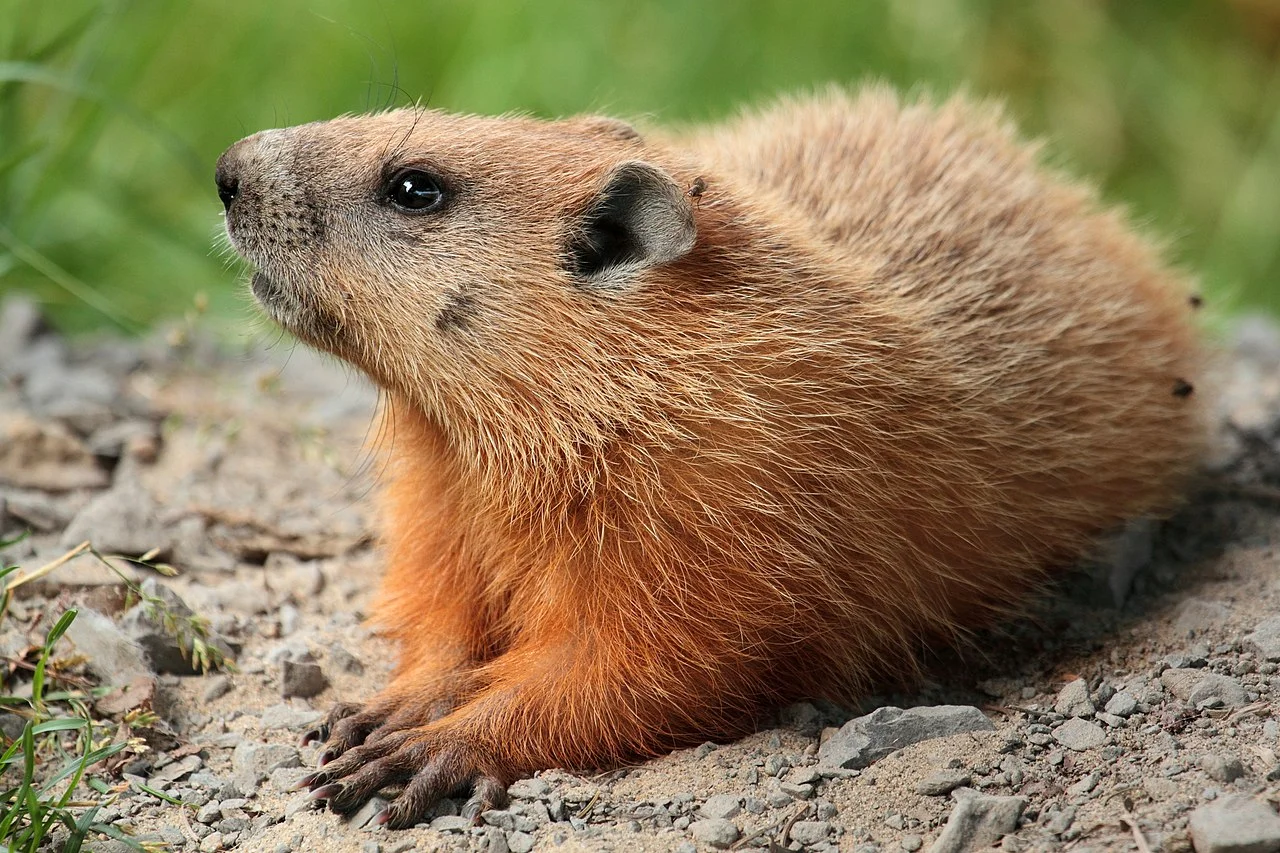
Muskrat:
Sleek, semi-aquatic rodent with dense, waterproof fur.
Streamlined body, slightly flattened tail, and small ears.
Typically brown, with a lighter underbelly.
Woodchuck:
Terrestrial rodent with a robust build.
Fur color ranges from brown to grayish-brown.
Short legs, bushy tail, and well-adapted for burrowing.
Comparison:
Muskrats are adapted for semi-aquatic life, with a streamlined body and flattened tail.
Woodchucks are built for terrestrial life, with strong limbs and digging capabilities.
Ecological Implications:
Muskrats contribute to wetland ecosystems by influencing vegetation and creating habitat.
Woodchucks play a role in soil aeration through burrowing, affecting local plant growth.
3. Size:
Muskrat:
Length: 16 to 24 inches (41 to 61 cm)
Tail: 7 to 11 inches (18 to 28 cm)
Woodchuck:
Length: 16 to 26 inches (41 to 66 cm)
Tail: 4 to 7 inches (10 to 18 cm)
Comparison:
Similar in overall length, but muskrats tend to have longer tails relative to their bodies.
Ecological Implications:
Size impacts the availability of suitable habitats and potential interactions with predators.
4. Weight:
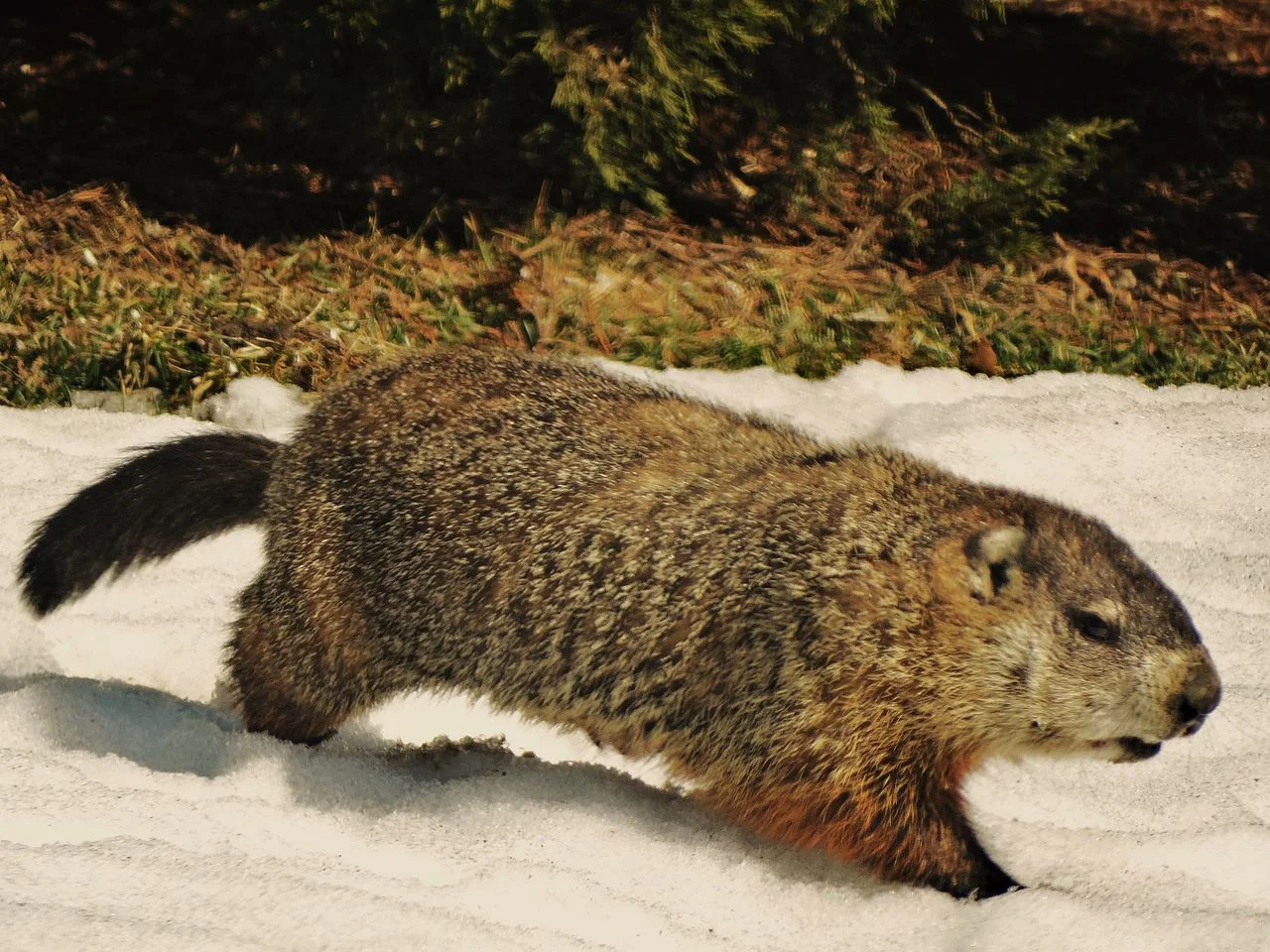
Muskrat:
Weight: 1.5 to 4.5 pounds (0.7 to 2 kg)
Woodchuck:
Weight: 4 to 14 pounds (1.8 to 6.4 kg)
Comparison:
Woodchucks are generally heavier than muskrats.
Ecological Implications:
Weight influences resource requirements, competition, and predator-prey dynamics.
5. Dentition and Bite Force (PSI):
Muskrat:
Sharp incisors for cutting vegetation.
Bite force: PSI not well-documented but adapted for plant material.
Woodchuck:
Large incisors for gnawing on plants and burrow construction.
Bite force: PSI not well-documented but adapted for herbivorous diet.
Comparison:
Both species have adapted dentition for herbivorous diets.
Ecological Implications:
Their dental adaptations impact plant communities and may influence the structure of local ecosystems.
6. Physical Offensive Advantages:
Muskrat:
Sharp incisors for defense and cutting vegetation.
Woodchuck:
Strong forelimbs and sharp incisors for burrow construction and self-defense.
Comparison:
Muskrats may rely more on agility, while woodchucks use their powerful limbs for defense.
Ecological Implications:
Defensive mechanisms impact interactions with predators and shape local ecosystems.
7. Physical Defensive Advantages:
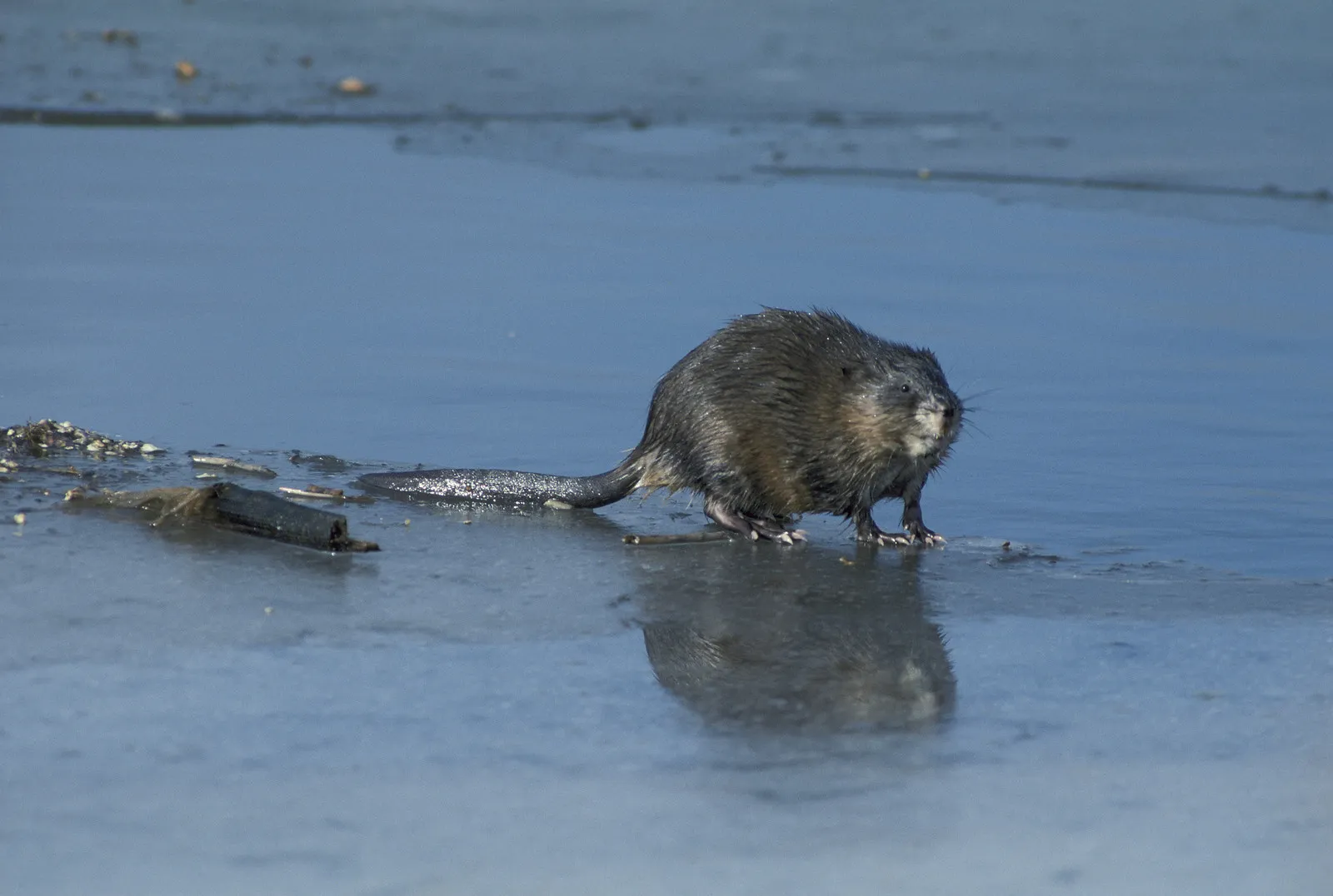
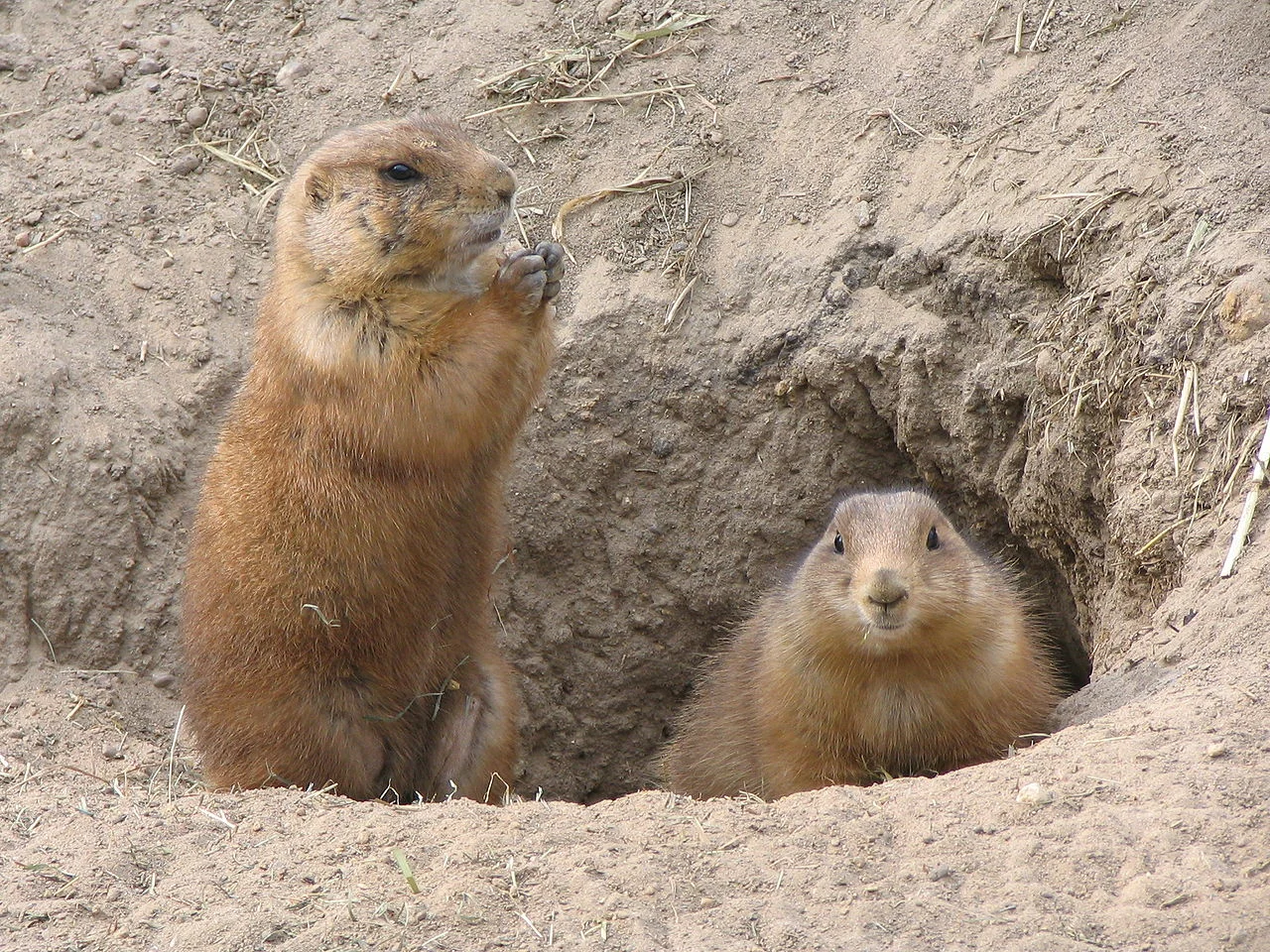
Muskrat:
Agility and ability to escape into water for safety.
Woodchuck:
Retreat to burrows and use powerful limbs for self-defense.
Comparison:
Muskrats excel in aquatic evasion, while woodchucks utilize burrows for protection.
Ecological Implications:
Defensive strategies influence predator-prey dynamics and habitat utilization.
8. Speed (Km/hour or Mile/hour):
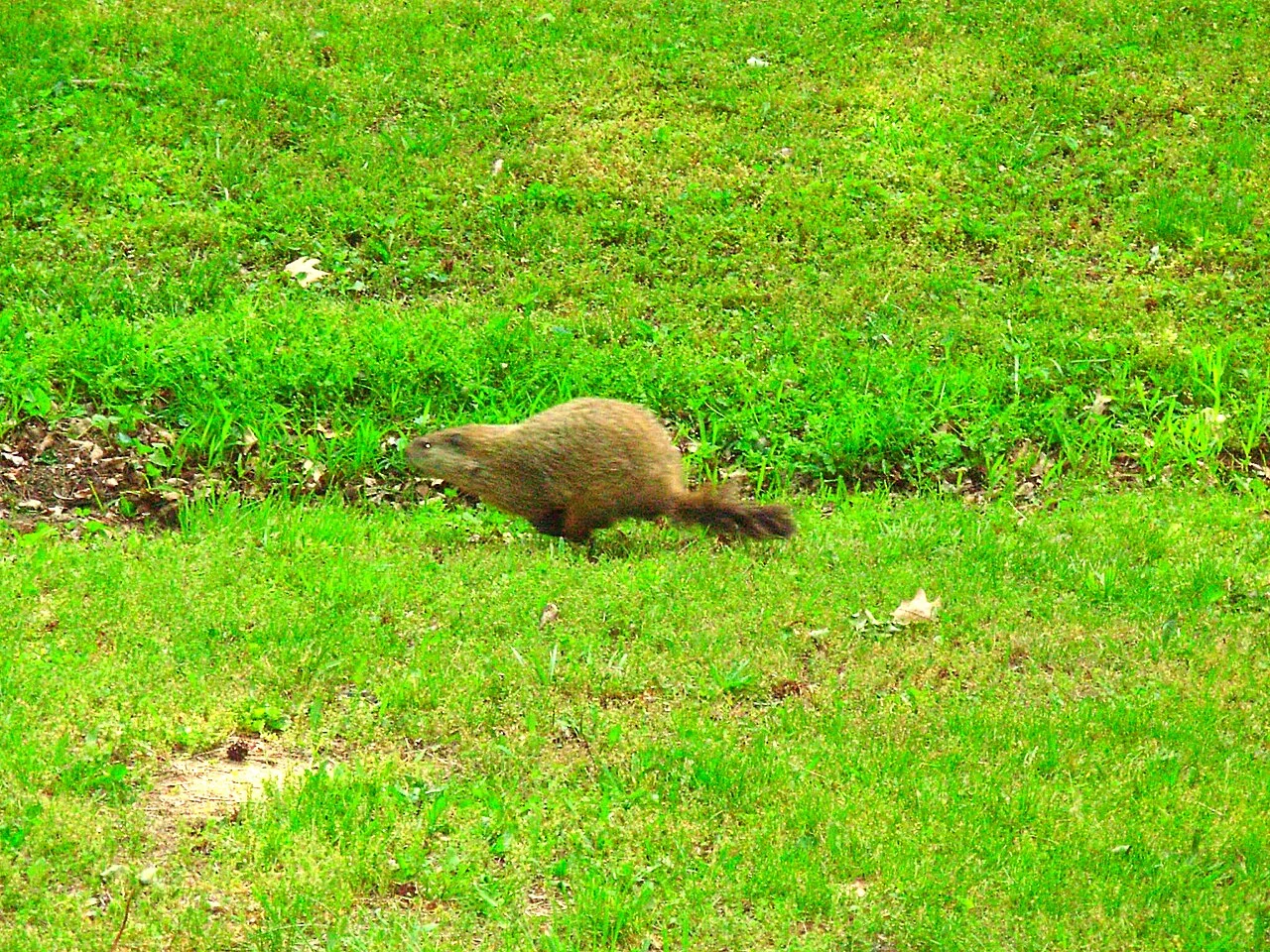
Muskrat:
Agile swimmers, capable of reaching speeds around 3.5 mph (5.6 km/h).
Woodchuck:
Land-dwelling, with a running speed of up to 8 mph (12.9 km/h).
Comparison:
Muskrats are faster in water, while woodchucks are more agile on land.
Ecological Implications:
Speed affects foraging efficiency, escape from predators, and overall survival strategies.
9. Agility:
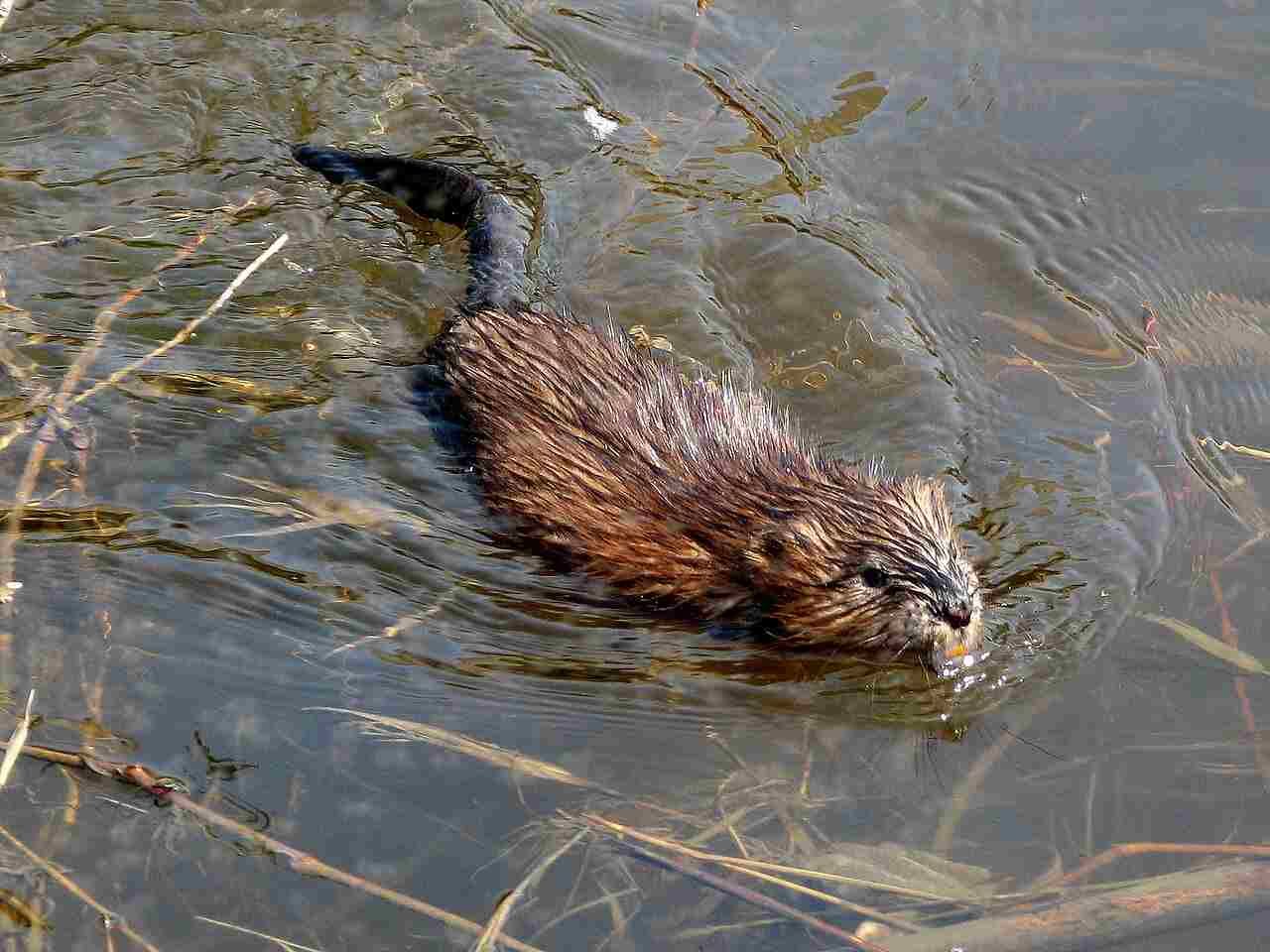
Muskrat:
Highly agile in water, navigating through aquatic vegetation.
Woodchuck:
Agile on land, capable of climbing, digging, and navigating through burrow systems.
Comparison:
Each species has evolved agility traits suited to its predominant habitat.
Ecological Implications:
Adaptation to specific environments influences resource acquisition and survival.
10. Senses:
Muskrat:
Well-developed senses of touch and hearing; good night vision.
Woodchuck:
Excellent sense of smell, good hearing, and decent vision.
Comparison:
Muskrats rely on touch and hearing, while woodchucks emphasize smell for detection.
Ecological Implications:
Varied sensory adaptations impact how each species interacts with its environment and detects threats.
11. Overall Physical Capacity:
Muskrat:
Well-adapted for aquatic life, with strong swimming abilities.
Woodchuck:
Strong limbs for burrow construction and a robust build for terrestrial activities.
Comparison:
Muskrats excel in water-related activities, while woodchucks are adapted for life on land.
Ecological Implications:
Physical capacities shape ecological roles, affecting habitat use and resource utilization.
12. Habitat Preference(s) and Geographic Region:
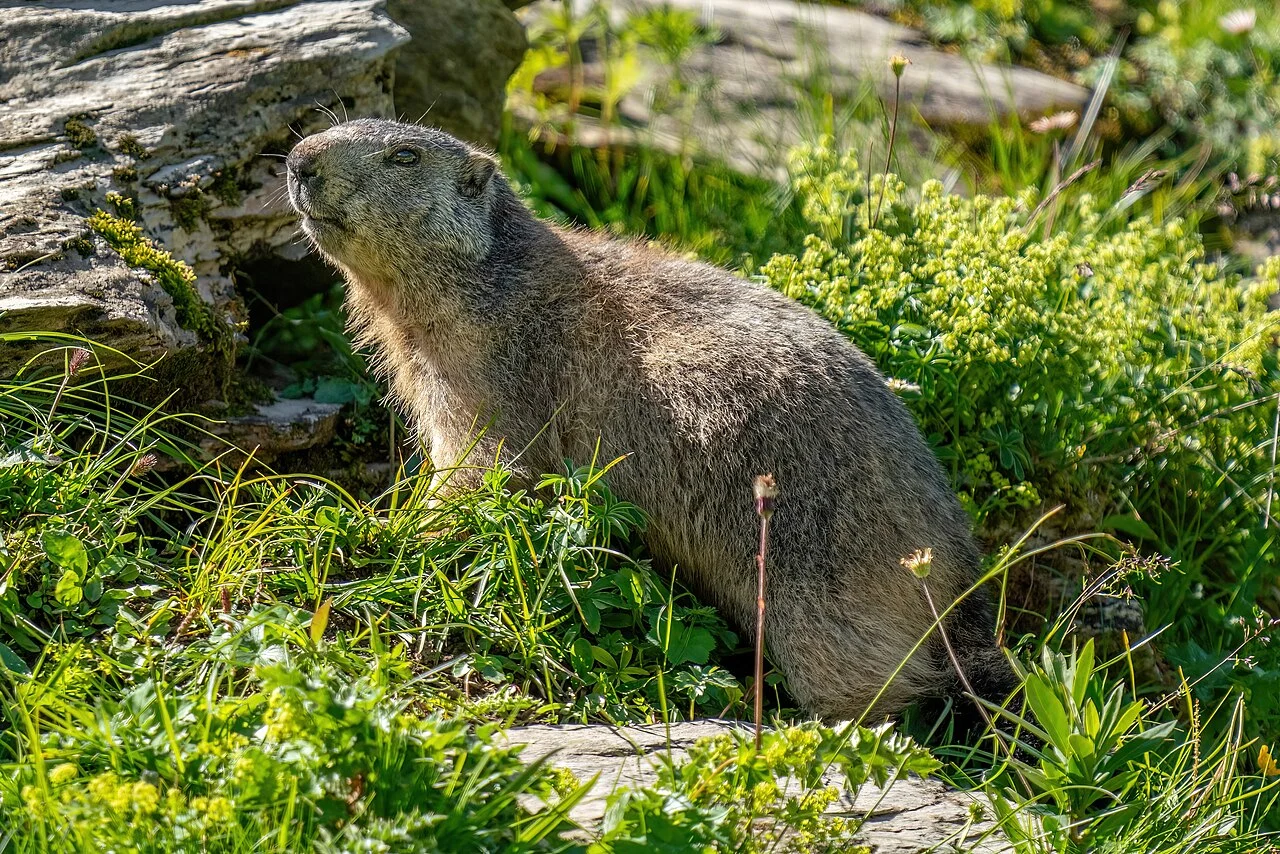
Muskrat:
Prefers wetlands, ponds, and slow-moving streams; widespread across North America.
Woodchuck:
Inhabits open areas near woodlands, fields, and meadows; common in North America.
Comparison:
Muskrats favor aquatic habitats, while woodchucks are more terrestrial in their preferences.
Ecological Implications:
Habitat preferences influence ecosystem dynamics and interactions with other species.
13. Tracks:
Muskrat:
Small, webbed footprints leading to and from water sources.
Woodchuck:
Distinctive prints with five toes on both front and hind feet, often found near burrow entrances.
Comparison:
Track morphology reflects the different locomotion styles and habitats of each species.
Ecological Implications:
Tracking can aid in monitoring and studying the distribution and behavior of these rodents in the wild.
14. Lifespan:
Muskrat:
Typically lives 2 to 4 years in the wild.
Woodchuck:
Average lifespan ranges from 6 to 8 years.
Comparison:
Woodchucks generally have a longer lifespan compared to muskrats.
Ecological Implications:
Lifespan impacts population dynamics, reproductive strategies, and overall ecological contributions.
15. Mode of Feeding:
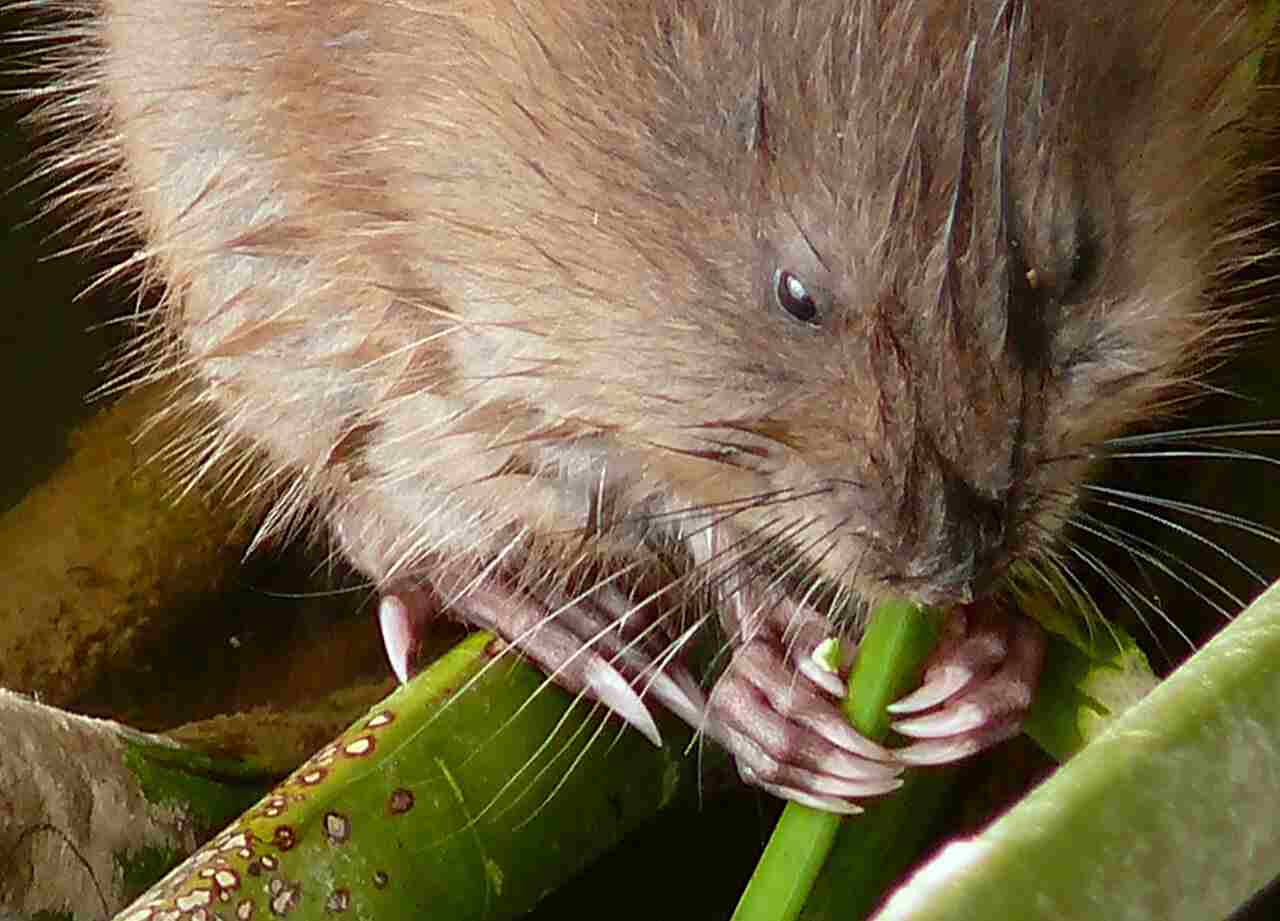
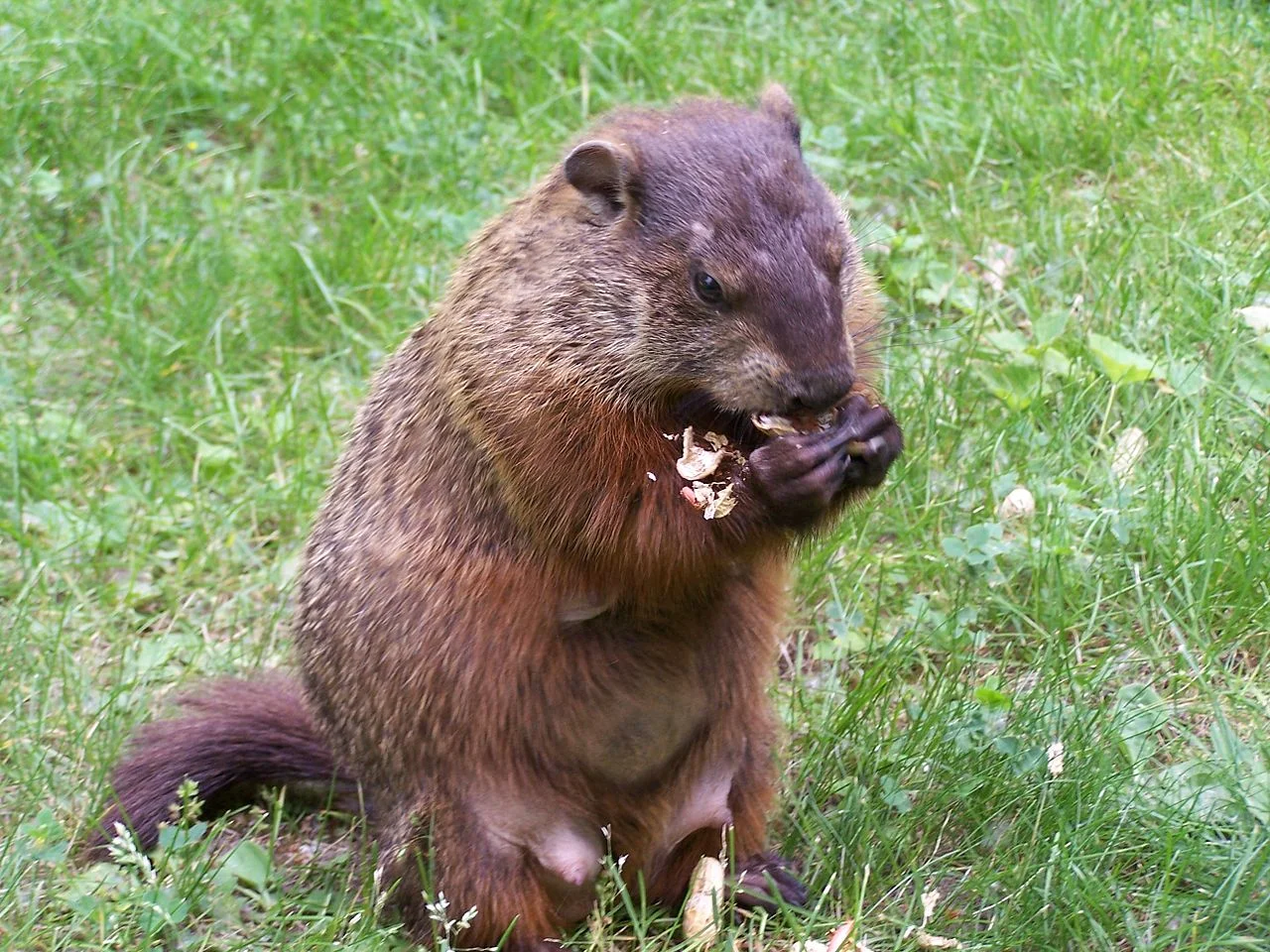
Muskrat:
Herbivorous, primarily feeding on aquatic vegetation, roots, and stems.
Woodchuck:
Herbivorous, consuming a variety of plants, fruits, and vegetables.
Comparison:
Both species share a herbivorous diet, but their specific food preferences may differ.
Ecological Implications:
Dietary choices influence vegetation dynamics, impacting the structure of local ecosystems.
16. Intelligence:
Muskrat:
Limited cognitive abilities, with a focus on instinctual behaviors.
Woodchuck:
Considered intelligent, displaying problem-solving skills, and demonstrating learning capabilities.
Comparison:
Woodchucks exhibit higher cognitive abilities compared to muskrats.
Ecological Implications:
Intelligence influences adaptive behaviors, foraging strategies, and responses to environmental changes.
17. Social Behavior:
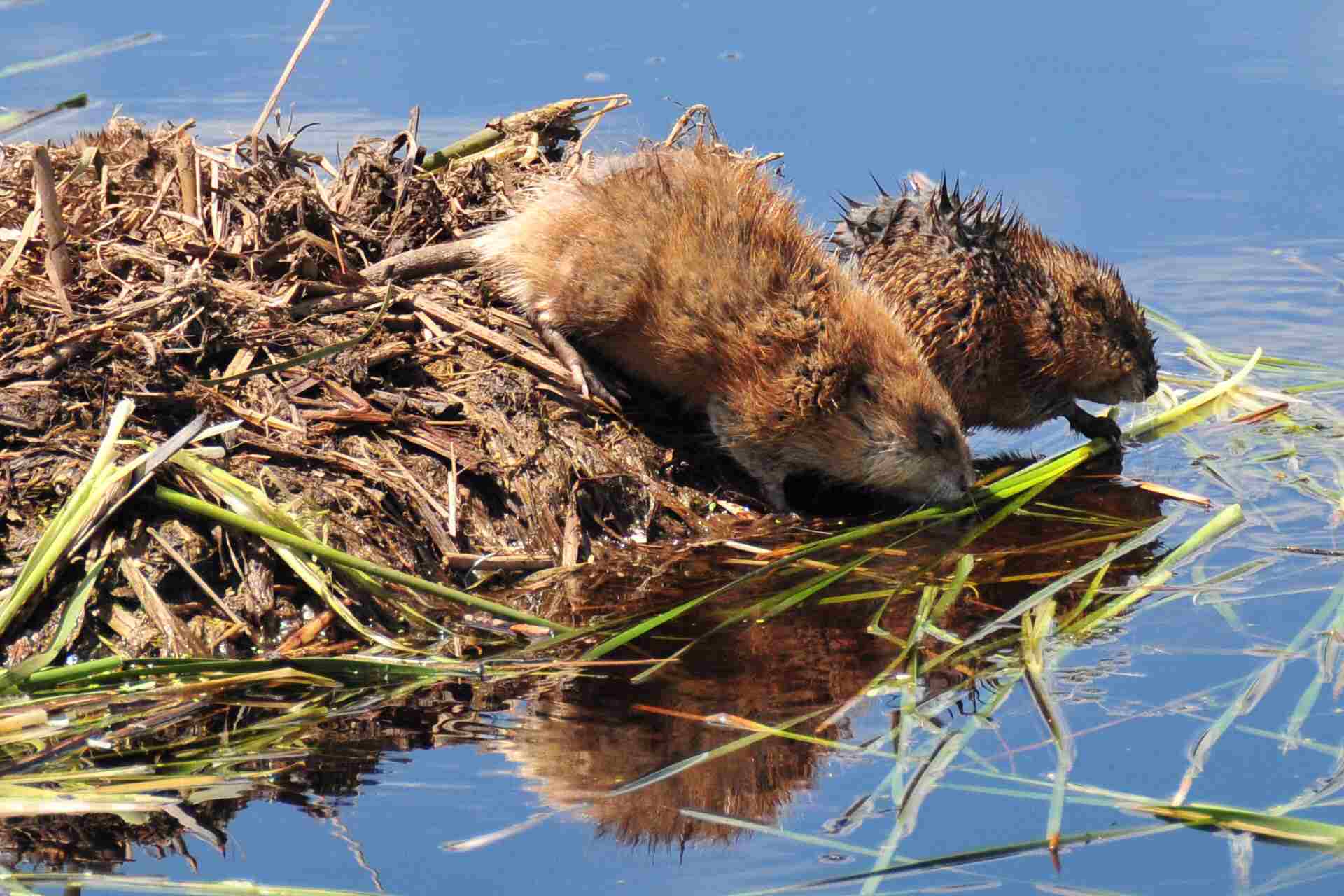
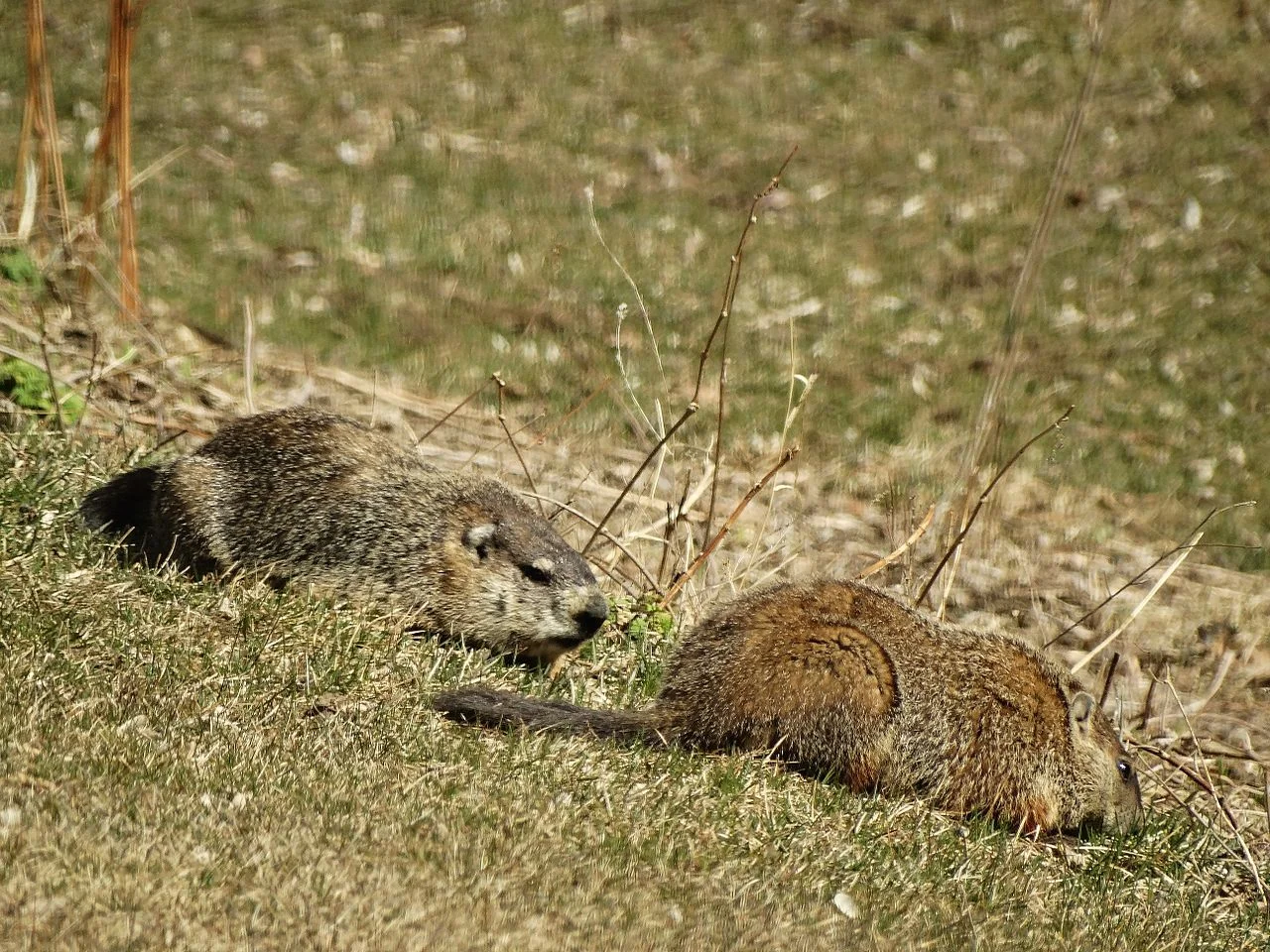
Muskrat:
Generally solitary, territorial, with limited social interactions.
Woodchuck:
Primarily solitary, but can tolerate conspecifics in overlapping territories.
Comparison:
Both species exhibit solitary tendencies, but woodchucks may tolerate proximity more than muskrats.
Ecological Implications:
Social behavior affects population dynamics, resource competition, and territory establishment.
18. Mode of Reproduction:
Muskrat:
Seasonal breeding, with multiple litters per year.
Gestation period of about 28 days.
Woodchuck:
Seasonal breeders with one litter per year.
Gestation period lasts approximately 31 days.
Comparison:
Muskrats have multiple litters annually, while woodchucks have a single annual reproductive event.
Ecological Implications:
Reproductive strategies impact population size, dynamics, and resource utilization.
19. Parental Behavior:
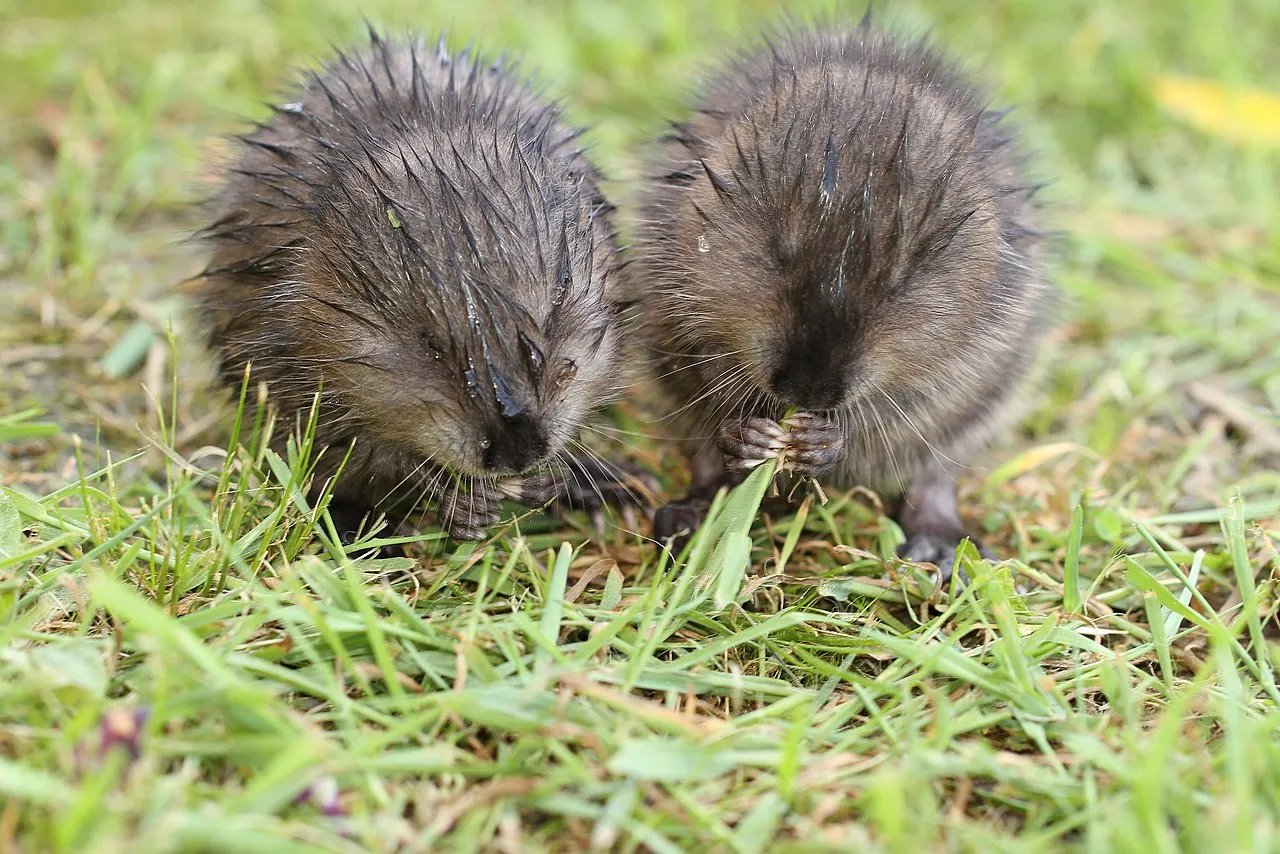
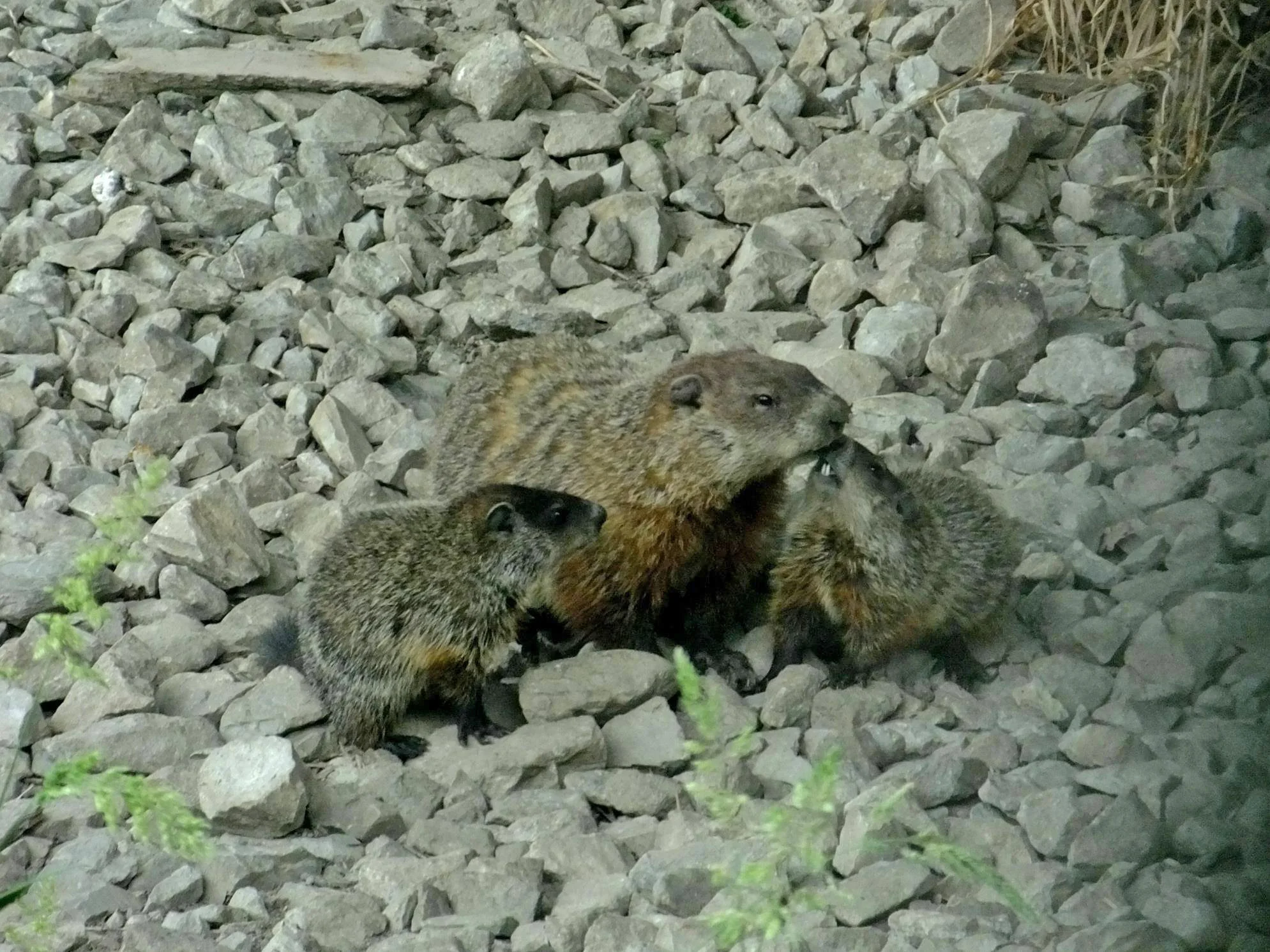
Muskrat:
Limited parental care; young are precocial and independent shortly after birth.
Woodchuck:
Females provide maternal care to their altricial young, nursing and protecting them in the burrow.
Comparison:
Woodchucks exhibit more extensive parental care compared to muskrats.
Ecological Implications:
Parental behaviors influence offspring survival rates and population dynamics.
20. Proximity to Human-Inhabited Areas:
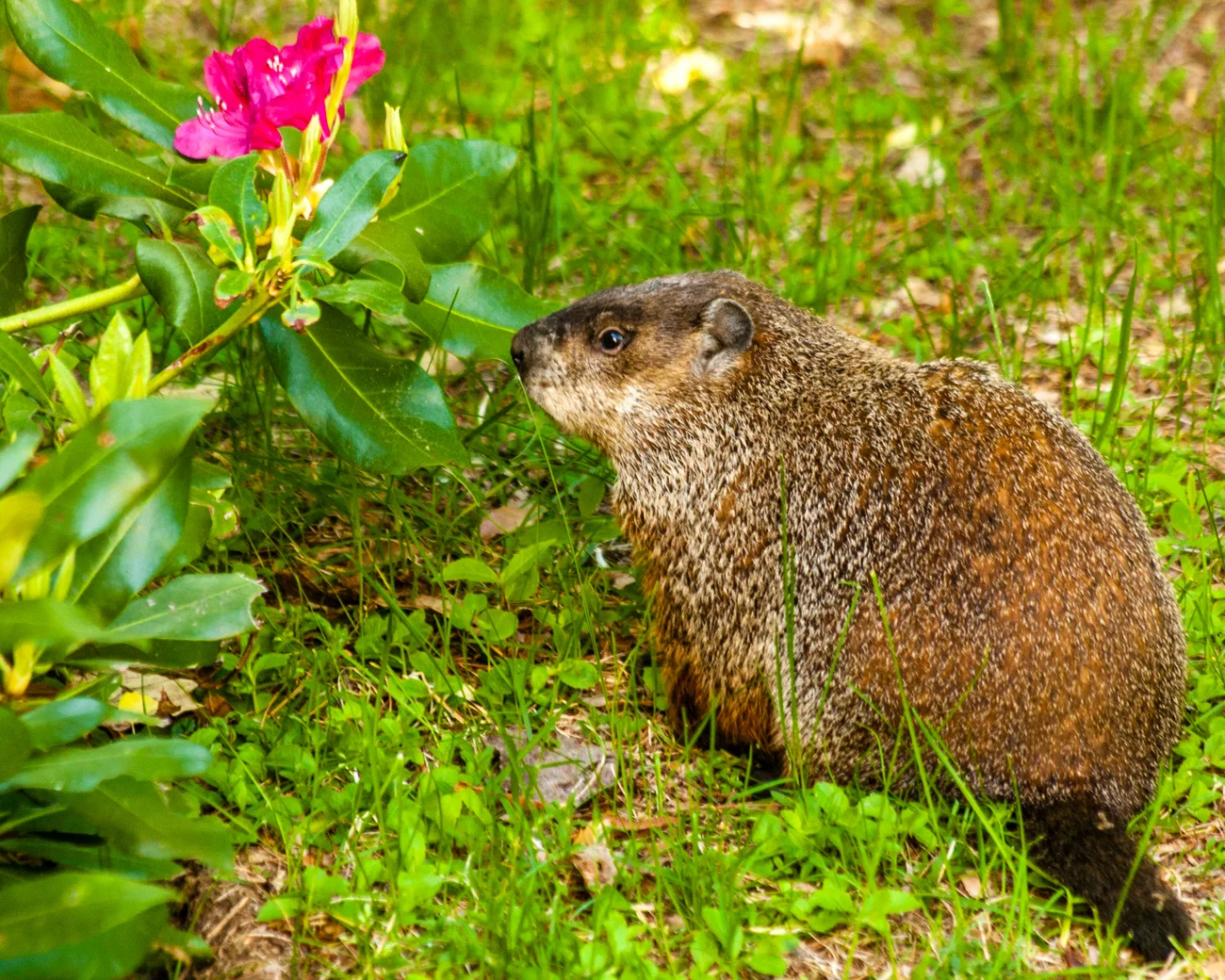
Muskrat:
Can be found near human-inhabited areas, particularly in wetlands and water bodies.
Woodchuck:
Commonly encountered in suburban and rural areas, often near fields and gardens.
Comparison:
Both species can adapt to human-altered environments.
Ecological Implications:
Proximity to humans may lead to interactions and potential conflicts, impacting both the rodents and human activities.
21. Behavior Toward Humans:
Muskrat:
Generally avoids direct contact with humans but may be observed in wetland areas.
Woodchuck:
Tends to retreat to burrows when approached but may become accustomed to human presence in suburban settings.
Comparison:
While both species may exhibit avoidance behaviors, woodchucks may tolerate closer proximity.
Ecological Implications:
Behavioral responses to humans influence coexistence and potential ecological impacts in human-inhabited areas.
22. Danger Posed to Humans:
Muskrat:
Generally poses little to no danger to humans; non-aggressive and avoids direct confrontation.
Woodchuck:
Rarely poses a direct threat, but may become defensive if cornered or feel threatened.
Comparison:
Both species are not typically considered dangerous to humans.
Ecological Implications:
Limited danger to humans contributes to the coexistence of these rodents in various environments.
23. Associated Precautions:
Muskrat:
Caution should be taken to avoid disrupting their habitats, especially in wetland areas.
Woodchuck:
Be mindful of burrows, as collapse can occur; relocate or protect garden structures if woodchucks become a nuisance.
Comparison:
Precautions focus on habitat conservation for muskrats and structural protection in areas with woodchuck burrows.
Ecological Implications:
Human awareness and precautions can mitigate potential negative impacts on both species and their habitats.
24. Conservation Status:
Muskrat:
Least Concern (LC) on the IUCN Red List; populations generally stable.
Woodchuck:
Not globally assessed, but populations are generally stable; considered of Least Concern.
Comparison:
Both species are not currently at risk of significant population decline.
Ecological Implications:
Stable populations indicate a balanced ecological relationship with their respective habitats.
*Summary of Comparison
Taxonomy:
Muskrat: Order Rodentia, Family Cricetidae, Genus Ondatra, Species O. zibethicus.
Woodchuck: Order Rodentia, Family Sciuridae, Genus Marmota, Species M. monax.
Appearance:
Muskrat: Streamlined, semi-aquatic with brown fur, flattened tail.
Woodchuck: Terrestrial, robust build, brown to grayish-brown fur.
Size:
Muskrat: 16-24 inches in length.
Woodchuck: 16-26 inches in length.
Weight:
Muskrat: 1.5-4.5 pounds.
Woodchuck: 4-14 pounds.
Dentition and Bite Force (PSI):
Muskrat: Sharp incisors for cutting vegetation.
Woodchuck: Large incisors for gnawing, strong bite force.
Physical Offensive Advantages:
Muskrat: Agility and sharp incisors.
Woodchuck: Strong forelimbs and sharp incisors.
Physical Defensive Advantages:
Muskrat: Aquatic evasion.
Woodchuck: Retreat to burrows, strong limbs for defense.
Speed:
Muskrat: Agile swimmers, ~3.5 mph.
Woodchuck: Terrestrial runners, up to 8 mph.
Agility:
Muskrat: Agile in water.
Woodchuck: Agile on land, climbs, and digs.
Senses:
Muskrat: Touch, hearing, good night vision.
Woodchuck: Smell, good hearing, decent vision.
Overall Physical Capacity:
Muskrat: Adapted for aquatic life.
Woodchuck: Strong limbs for terrestrial life.
Habitat Preference(s) and Geographic Region:
Muskrat: Wetlands, ponds; widespread in North America.
Woodchuck: Open areas near woodlands; common in North America.
Tracks:
Muskrat: Small, webbed footprints near water.
Woodchuck: Distinctive prints with five toes, near burrows.
Lifespan:
Muskrat: 2-4 years.
Woodchuck: 6-8 years.
Mode of Feeding:
Muskrat: Herbivorous, aquatic vegetation.
Woodchuck: Herbivorous, various plants.
Intelligence:
Muskrat: Limited cognitive abilities.
Woodchuck: Considered intelligent, problem-solving.
Social Behavior:
Muskrat: Generally solitary.
Woodchuck: Primarily solitary, tolerant of conspecifics.
Mode of Reproduction:
Muskrat: Seasonal breeding, multiple litters.
Woodchuck: Seasonal breeding, one litter per year.
Parental Behavior:
Muskrat: Limited parental care.
Woodchuck: Maternal care, nursing, and protection.
Proximity to Human-Inhabited Areas:
Muskrat: Wetland areas near humans.
Woodchuck: Suburban and rural areas.
Behavior Toward Humans:
Muskrat: Avoids direct contact.
Woodchuck: Retreats to burrows, may tolerate human presence.
Danger Posed to Humans:
Both species are generally not considered dangerous.
Associated Precautions:
Muskrat: Preserve wetland habitats.
Woodchuck: Be cautious around burrows.
Conservation Status:
Muskrat: Least Concern (LC).
Woodchuck: Not globally assessed, stable populations.
Conclusion
I. Similarities:
– Both are herbivorous rodents with adaptations to their specific habitats. – Exhibit avoidance behaviors toward humans.
II. Differences:
– Woodchucks have a longer lifespan and more extensive parental care than muskrats. – Muskrats are more adapted to aquatic environments, while woodchucks excel in terrestrial burrowing activities.
